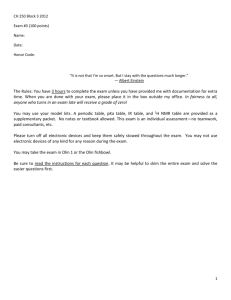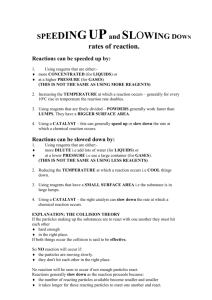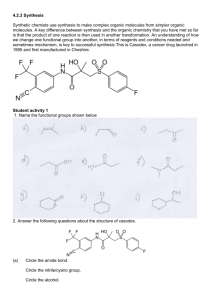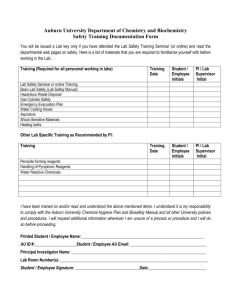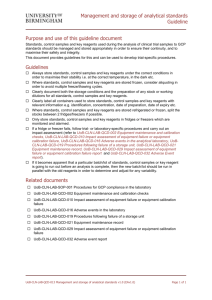Organic Chemistry - University of Warwick
advertisement
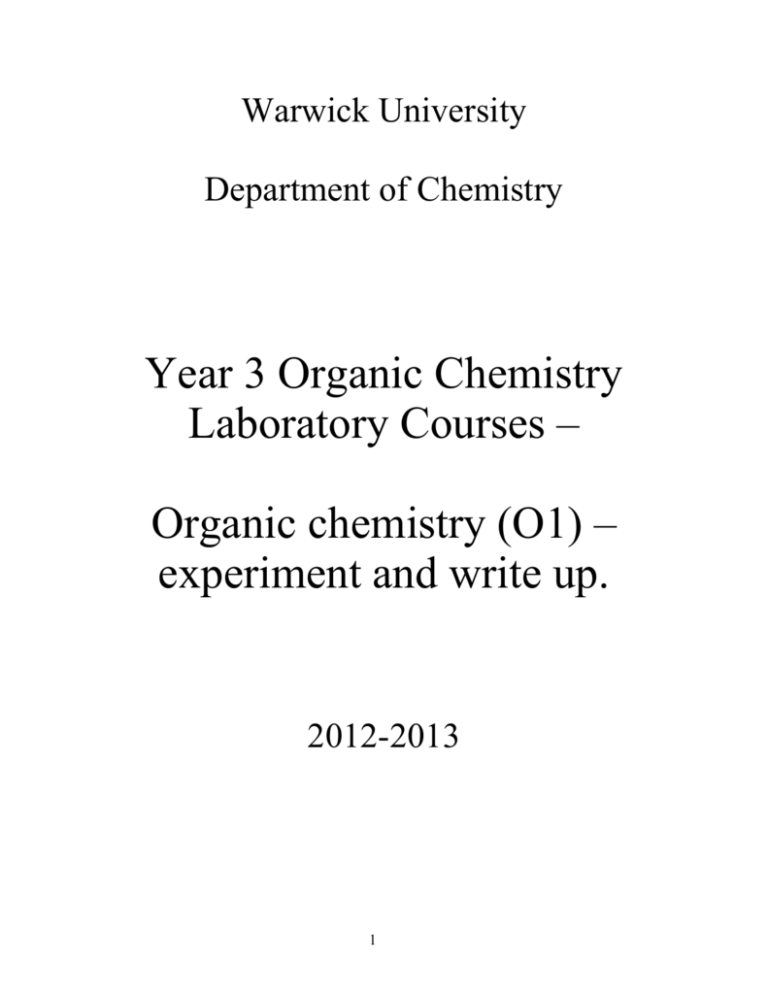
Warwick University Department of Chemistry Year 3 Organic Chemistry Laboratory Courses – Organic chemistry (O1) – experiment and write up. 2012-2013 1 Year 3 Organic Chemistry course O1. Introduction It is of vital importance that you read thoroughly the information obtained in this course manual and attend the pre-lab talk. You should also read the accompanying ‘Experimental techniques and methods booklet‘ before starting this course. Reaction sequence: The objective of the experiments is for each of you to generate one of a number of members of a library of compounds using a common sequence of reactions. The transformations which you will undertake are shown in the Scheme below. You should note that the illustrated route is a general one, but each of you will make only one derivative, i.e. one final compound. 2 Your exact target molecule will be assigned (by drawing at random from a ‘hat’) at the start of the course. Note: The actual amounts which you will use in the experiments will, of course, depend on the molecular mass of the exact reagents which you use. All reagents should be treated as hazardous and toxic, contained in the fume cupboard at all times unless in sealed containers and disposed of in an appropriate manner. Experimental procedures: Step 1) Substitution of the phenolic group. For this step a mild base will be used to deprotonate the phenolic hydroxy group. Too strong a base will result in the unwanted formation of an enolate. The resulting phenolic anion is a good nucleophile and will react with one of the four chosen electrophilic reagents which are to be employed. Note, you MUST start with 3.0 g of your ortho-hydroxy acetophenone (whichever one it is) and BASE YOUR CALCULATIONS ON THIS. A typical experimental procedure is as follows (adapted from C. Chen, Y.-F. Zhu and K. Wilcoxen, J. Org. Chem., 2000, 65, 2574-2576): A solution of ortho-hydroxy acetophenone (3.0g, 22 mmol, 1 eq.) in dry DMF (dimethylformamide) (50mL) at room temperature was treated with potassium carbonate (9.1g, 66mmol, 3.0 eq.), parachlorobenzyl chloride (3.54g, 22 mmol, 1.0 eq – make sure you use same no. of equivalents if you have a different electrophile) and tetraethylammonium iodide (0.4g, 1.1 mmol, catalytic amount). This solution was stirred at room temperature overnight (or until the next laboratory day). After this time, pour the DMF reaction mixture into an excess of stirred water (about 200 mL) and stir for 5 minutes - any solid that forms should be filtered off and recrystallised. If a solid does not form then follow the sequence below to extract the product: Diethylether (50 mL) was added and the resulting solution was thoroughly mixed in a separating funnel. The diethyether layer was then separated and the aqueous layer was extracted with further diethyether (2 x 50 mL). ALL of the diethylether fractions were combined, and washed with water (2 x 20 mL). Note that this is important, to ensure that as much of the DMF as possible is removed from the product. The washed ether layers 3 were dried (magnesium sulfate), filtered and the solvent removed under vacuum (rotary evaporator). 1H-NMR and IR spectra of the dried product should be recorded, however make sure that the final compound has been dried for at least 30 minutes in a desiccator before any data is recorded (see below). You must carry out a TLC analysis of your purified product against the ortho-hydroxy acetophenone starting material to establish that they have fully reacted and that the product is pure. Do not TLC the alkylating reagent, as this has hazardous properties. This will also establish which solvent you need for TLC analysis in subsequent steps. CAUTION: Benzyl halides are lacrymatory and irritant and should be handled with great care. They not be removed from the fume cupboard other than in a sealed container and any gloves which have been in contact with them should not be used outside the fume cupboard. All used glassware should be soaked overnight with dilute NaOH solution before cleaning. All benzylic chlorides and bromides and the other electrophilic reagents used in this step should be treated with the same degree of caution. Step 2) Reduction of the ketone to an alcohol Sodium borohydride will be used to achieve the required reduction in this procedure. This is probably the most common method for the synthesis of racemic alcohols. A typical procedure is as follows; Add your substrate (5.0g) to a solution of methanol (40 mL) and water (4 mL). At room temperature, with stirring, carefully add one molar equivalent of sodium borohydride (calculate the amount that you need and check with a demonstrator before starting the experiment). Leave the solution stirring for about 1 h. and then check the reaction by TLC after one hour or so. If the reduction is not complete then add a further 0.1 eq ofNaBH4 leave it stirring for longer and check at hourly intervals. At the end of the reaction the methanol should be removed using a rotary evaporator. Water (50 mL for a 5g scale) should be added. The product is then extracted with diethylether (ca. 3 x 50 mL). The combined diethylether extracts should be dried (sodium or magnesium sulfate), filtered, and the solvent removed using a rotary evaporator to give a crude product which is then purified by a suitable method (e.g. recrystallization) and characterised by 1H-NMR and IR. NB: It is unlikely that your reaction will be carried out on a larger scale than that described above. 4 Step 3) Formation of the ester. In the final step you will make one of two possible ester derivatives, as indicated by the structure of your desired final compound. For this step of your synthetic sequence, we would like you to devise a procedure for the reaction. This should be achieved by consulting textbooks of your choice and by using databases, such as Scifinder Scholar. You should try to find an actual procedure for the reaction, which will require the use of either triethylamine or pyridine (i.e.as the base) and a suitable solvent. The use of an excess of base may give an improved result compared to the use of a stoichiometric amount. Take into account the cost and likely availability of any reagents you may wish to use and ensure that you discuss your chosen process with a demonstrator before starting the reaction. CAUTION: All benzylic chlorides and bromides, acyl chlorides and the other electrophilic reagents used in this step should be treated with the same degree of caution. None should leave the fume cupboard at any time. Dichloromethane should also be regarded as highly toxic and handled with due care. ________________________________________________________________________ 5 Writing up your work You should write up your experiments in an A4 bound-booklet (i.e. the same as in years 1 and 2) as you go along using the format described earlier in the ‘Experimental techniques and methods booklet’. The experimentals should contain all the important information such as quantities of material used, yield, procedure in detail etc. At the end of the laboratory course, when all the experiments have been completed, you should write up the results of your work, together with an analysis of your data, in the proforma (see below). The completed write-up proforma, your spectra and your labook should then be handed in to the undergraduate office by the deadline given at the end of the course. The write-up should be a maximum of 4 sides of A4 in length, written on the proforma required (see Appendix 1) and taped or stuck into your laboratory book after the individual records of each experiment. This will include the following sections (note there is no need to write out the entire procedure from the laboratory manual). The pieces of data underlined below must be obtained and added as an appendix after the write-up. i.e. you need to hand in your laboratory book with the writeup proforma and spectra stuck in it. Section 1: A summary of your experimental results (consisting of the following components): Step 1:Product: O X Y O A listing of names and quantities of reagents used. Any modifications to the general procedure. Details of purification and yield as (mass, moles, %), TLC details of the reaction as it was followed and illustrations of plates – NOT the original plates, as they contain hazardous materials. Melting point if applicable. Illustration of the particular derivative you have made. Retain a small sample (<50mg) and hand it in at the end of the course. 6 Step 2: Product: OH X O Y A listing of names and quantities of reagents used. Full details of how it was purified. Details of the reaction which you carried out with yields as (mass, moles, %). TLC details of the reaction as it was followed and illustrations of plates – NOT the original plates, as they contain hazardous materials. Melting point if applicable. Illustration of the particular derivative you have made. Retain a small sample (<50mg) and hand it in at the end of the course. Step 3: Product: Z O X O Y A listing of names and quantities of reagents used. A reference for the procedure you used. Details of the experiment, illustrations of the TLC plates – NOT the original plates, as they contain hazardous materials and yield as (mass, moles, %). Melting point if applicable. Illustration of the particular derivative you have made. The full sample of the final compound should be submitted to the course leader, fully labelled. Section 2: A full interpretation of the spectroscopic data for each of the compounds which have been prepared and purified above. Spectra for each intermediate: 1H-NMR and IR. This section should be structured in a logical way that allows you to prove or confirm the structure of the compound(s) which you have prepared. The analysis should include the following details (see the proforma): IR: just 2 major peaks, paying particular attention to the the main functional groups. 1H-NMR: Each peak from 0-10 ppm should be characterised in order of appearance in the spectrum from high to low. position (in ppm), no. of protons (from integral), multiplicity (i.e. doublet, triplet etc.), J values (coupling constants in Hz) and assignment (i.e. which H it is in the molecule, using the labelling scheme provided). Do not quote solvents or peaks which are not part of the structure. 7 Section 3: Reaction mechanisms: What are the mechanisms of each step of the synthesis you carried out (please illustrate in detail)? _______________________________________________________________________ Notes Your general competence will be assessed throughout the course by the demonstrators. They will note your attention to safety matters and your experimental technique. They will note your ability to answer questions about the experiment you are doing and the quality of the planning of each experiment you undertake. They will also take particular note of the general cleanliness and tidiness of your work. If you work in an untidy and unclean way (e.g. if you do not immediately attend to solid or liquid spills), you will have marks deducted. You have been given explicit guidance in the manual on how to keep a proper record of your experiments. The importance of keeping an accurate laboratory notebook cannot be overemphasised. If in doubt as to whether or not something should be recorded, remember the basic criterion that your experiments should be recorded in sufficient detail that another worker could repeat them exactly. (When you have written up an experiment, imagine that you are another chemist and ask yourself if you could repeat the experiment as described exactly.) Remember that work not recorded accurately = work not done. Sample quality is of paramount importance. The two things that are essential are that (i) the compounds you make are adequately characterised and that (ii) they are pure and that you have evidence of their purity. Remember that you must retain a reference sample of each compound you make, properly labelled with its structure, your name and the page number of you laboratory notebook in which its preparation is described. It is normally sufficient to retain 50-100 mg of a compound as a reference standard. If for whatever reason your data are incomplete when you come to write up your report, with a reference sample in hand, you will, always be able to obtain the missing data. Your reference samples will be used by the demonstrators to allocate a mark for “quality of samples” (see above). 8 APPENDIX 1: Write-up proforma for O1 (download as word document from): http://www2.warwick.ac.uk/fac/sci/chemistry/research/willsgroup/teaching_materials. SUBMISSION DEADLINE: 12.00 noon one week after the end of the course Year 3 Organic Chemistry Laboratory O1 Report. 2012-2013 academic year Please read these instructions carefully: Any text in red can be deleted. Type your write up into this pro-forma or print it out and write on in (leaving suitable spaces where required). You can change the spacing between each heading and prompt, but you should not change the font size or type. However, the finished report should not exceed four pages in total (not counting the appended spectra). Paste this report into your laboratory book, with the three IR and three NMR spectra (see below), and hand it in to the undergraduate office. Student name: ______________________________ Section 1: Summary of experimental results. Part One: Alkylation of the ortho-hydroxy acetophenone: i) List reagents used (name, mass in g, no. moles): ii) Describe any changes to the laboratory procedure (do not write out the full procedure): iii) Give the yield of product you obtained (mass in g, no. moles, % obtained, solvent from which it was recrystalised if applicable), and melting point if it was a solid, and a picture of the TLC plate with solvents used: iv) Confirm that you have handed in a labelled (with your name and a diagram of the compound) sample by ticking this box: □ Part Two: Reduction of the ketone: i) List reagents used (name, mass in g, no. moles): ii) Describe any changes to the laboratory procedure (do not write out the full procedure). iii) Give the yield of product you obtained (mass in g, no. moles, % obtained, solvent from which it was recrystalised if applicable), and melting point if it was a solid, and a picture of the TLC plate with solvents used: iv) Confirm that you have handed in a labelled (with your name and a diagram of the compound) sample by ticking this box: □ Part Three: Acylation of the alcohol: i) List reagents used (name, mass in g, no. moles): 9 ii) Provide a literature reference for the procedure you used, and the reaction that relates to your work: iii) Describe the full procedure which you followed, including pictures of the TLC plate with solvents used: iv) Give the yield of product you obtained (mass in g, no. moles, % obtained, solvent from which it was recrystalised if applicable), and melting point if it was a solid: v) Confirm that you have handed in a labelled (with your name and a diagram of the compound) sample by ticking this box: □ Section 2: Spectroscopic data (attach ONE NMR spectrum and ONE IR spectrum per step at the end of the report). If you have more than one spectra of product, append only the one you have selected for the tables below. Draw a diagram of the molecule on the 1H-NMR spectrum, and label each proton or group of protons with (a,b,c…etc.) using the scheme below so that you can refer to them in the table*). You do not have to draw a diagram on the IR spectra. Step 1 product: IR spectrum: Complete the table, do not include more than 2 key absorptions, i.e. select only the most significant ones that support the proposed structure. Position Strong (S), Medium Functional group Bond stretch or /cm-1, highest first. (m) or weak (w)? creating the peak bend? NMR spectrum: Complete the table, add more rows if required. DO NOT include solvents or peaks unrelated to the product. Use this diagram to assign peaks a,b,c etc…: and list them in order of appearance in the spectrum from highest to lowest. Position of peak Integral Multiplicity (s, selected/ppm(), (relative no. of d, t, q, quin)** Hs) highest first. 10 J value if not a S or m) Proton(s) responsible for the peak (a,b,c..etc.*). ** s=singlet, d=doublet, t-triplet, q=quartet, quin=quintet, m=multiplet, dd=double doublet, etc. Please give ppm (d) values to two decimal places and couplings (J) values to 1 decimal place only. Step 2 product: IR spectrum: Complete the table, do not include more than 2 key absorptions, i.e. select only the most significant ones that support the proposed structure. Position Strong (S), Medium Functional group Bond stretch or -1 /cm , highest first. (m) or weak (w)? creating the peak bend? NMR spectrum: Complete the table, add more rows if required. DO NOT include solvents or peaks unrelated to the product. Use this diagram to assign peaks a,b,c etc…in same way as for product 1.: Position of peak selected/ppm(), highest first. Integral (relative no. of Hs) Multiplicity (s, d, t, q, quin)** J value if not a S or m) Proton(s) responsible for the peak (a,b,c..etc.*). ** s=singlet, d=doublet, t-triplet, q=quartet, quin=quintet, m=multiplet, dd=double doublet, etc. Please give ppm (d) values to two decimal places and couplings (J) values to 1 decimal place only. Step 3 product: IR spectrum: Complete the table, do not include more than 2 key absorptions, i.e. select only the most significant ones that support the proposed structure. Position of peak Strong (S), Medium Functional group Bond stretch or /cm-1, highest first. (m) or weak (w)? creating the peak bend? NMR spectrum: Complete the table, you may add more rows if required. DO NOT include solvents or peaks unrelated to the product. 11 Use this diagram to assign peaks a,b,c etc… in the same way as for product 1: Position selected/ppm(), highest first. Integral (relative no. of Hs) Multiplicity (s, d, t, q, quin)** J value(s) if not m or s) Proton(s) responsible for the peak (a,b,c..etc.*). ** s=singlet, d=doublet, t-triplet, q=quartet, quin=quintet, m=multiplet, dd=double doublet, etc. Please give ppm (d) values to two decimal places and coulings (J) values to 1 decimal place only. Section 3: Reaction mechanisms: Illustrate below (free hand or computer-drawn) the reaction mechanisms for each step of the synthesis you have carried out: 12 Year 3 Organic Laboratory ‘O1’ marking scheme. The marks are distributed as follows: Safe working 10% Lab notes 10% Quality of samples as assessed by sample and spectra, 30% Quality of spectroscopic interpretation 30% Design of last experiment 10% Mechanisms 10% Loss of marks; Students should be advised that marks will be reduced; i) if an experiment is not accompanied by a signed (by an academic) safety assessment, ii) if the final report is over 4 pages in length (with margins, but not counting spectra, which may be added as an appendix). Marks will also be reduced if the report is handed in late without permission or good reason. 13

